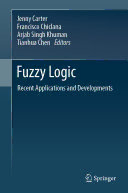Table Of ContentJenny Carter
Francisco Chiclana
Arjab Singh Khuman
Tianhua Chen Editors
Fuzzy Logic
Recent Applications and Developments
Fuzzy Logic
· ·
Jenny Carter Francisco Chiclana
·
Arjab Singh Khuman Tianhua Chen
Editors
Fuzzy Logic
Recent Applications and Developments
Editors
JennyCarter FranciscoChiclana
DepartmentofComputerScience FacultyofComputing
UniversityofHuddersfield EngineeringandMedia
Huddersfield,UK DeMontfortUniversity
Leicester,UK
ArjabSinghKhuman
FacultyofComputing TianhuaChen
EngineeringandMedia DepartmentofComputerScience
DeMontfortUniversity UniversityofHuddersfield
Leicester,UK Huddersfield,UK
ISBN978-3-030-66473-2 ISBN978-3-030-66474-9 (eBook)
https://doi.org/10.1007/978-3-030-66474-9
©SpringerNatureSwitzerlandAG2021
Thisworkissubjecttocopyright.AllrightsaresolelyandexclusivelylicensedbythePublisher,whether
thewholeorpartofthematerialisconcerned,specificallytherightsoftranslation,reprinting,reuse
ofillustrations,recitation,broadcasting,reproductiononmicrofilmsorinanyotherphysicalway,and
transmissionorinformationstorageandretrieval,electronicadaptation,computersoftware,orbysimilar
ordissimilarmethodologynowknownorhereafterdeveloped.
Theuseofgeneraldescriptivenames,registerednames,trademarks,servicemarks,etc.inthispublication
doesnotimply,evenintheabsenceofaspecificstatement,thatsuchnamesareexemptfromtherelevant
protectivelawsandregulationsandthereforefreeforgeneraluse.
Thepublisher,theauthorsandtheeditorsaresafetoassumethattheadviceandinformationinthisbook
arebelievedtobetrueandaccurateatthedateofpublication.Neitherthepublishernortheauthorsor
theeditorsgiveawarranty,expressedorimplied,withrespecttothematerialcontainedhereinorforany
errorsoromissionsthatmayhavebeenmade.Thepublisherremainsneutralwithregardtojurisdictional
claimsinpublishedmapsandinstitutionalaffiliations.
ThisSpringerimprintispublishedbytheregisteredcompanySpringerNatureSwitzerlandAG
Theregisteredcompanyaddressis:Gewerbestrasse11,6330Cham,Switzerland
Preface
Many problems within industry and commerce can be modelled mathematically
and/or statistically. However, in practice, applications modelled in this way often
performpoorly.Implementedassumptionscancausedevelopedsolutionstolacka
certain level of robustness. Standard control applications, for example, often work
poorlyundercertainconditionsortheyarenotsmoothintheirmovement.Physical
measurementsare,bytheirnature,imprecise.Theyareonlyasgoodastheinstrument
doingthemeasuring.A2Kgbagofsugarisnever‘exactly’2Kgforexample.Yet,
traditionalmathematicallybasedcontrolsolutionsusesuchmeasurementsasbeing
precise. Experts make decisions with imprecise data in an uncertain world. They
work with knowledge that is rarely defined mathematically or algorithmically but
usesvagueterminologywithwords.
Fuzzy logic relies on the concept of a fuzzy set, which was proposed by Lotfi
Zadeh, in his 1965 seminal paper—‘Fuzzy Sets’ (published in Information and
Control,volume8,pp.338–353).ZadehwasaProfessorattheUniversityofSouthern
California until his death in 2017. The idea of fuzzy sets described in his seminal
work lays the basis for Fuzzy Logic. Fuzzy Logic is particularly good at handling
uncertainty,vaguenessandimprecision.Thisisveryusefulwhereaproblemcanbe
describedlinguistically(usingwords)or,aswithneuralnetworks,wherethereisdata
andyouarelookingforrelationshipsorpatternswithinthatdata.FuzzyLogicuses
imprecisiontoproviderobustsolutionstoproblems.Applicationsoffuzzylogicare
variedandincluderobotics,washingmachinecontrol,nuclearreactors,information
retrieval,trainscheduling,systemmodelling,camerafocus,stocktracking.
Thechaptersinthisbookprovidefurtherinsightintothewiderangeofapproaches
to problem-solving using fuzzy logic and illustrate these approaches over a wide
varietyofapplicationareas.
TheEditors
Huddersfield,UK JennyCarter
Leicester,UK FranciscoChiclana
Leicester,UK ArjabSinghKhuman
Huddersfield,UK TianhuaChen
v
Contents
FuzzyLogic,aLogician’sPerspective ............................... 1
PatrickFogarty
AFuzzyApproachtoSentimentAnalysisattheSentenceLevel ........ 11
OrestesAppel,FranciscoChiclana,JenniferCarter,andHamidoFujita
ConsensusinSentimentAnalysis .................................... 35
OrestesAppel,FranciscoChiclana,JenniferCarter,andHamidoFujita
FosteringPositivePersonalisationThroughFuzzyClustering .......... 51
RaymondMoodley
DiagnosingAlzheimer’sDiseaseUsingaSelf-organisingFuzzy
Classifier ......................................................... 69
JonathanStirling,TianhuaChen,andMagdaBucholc
AutismSpectrumDisorderClassificationUsingaSelf-organising
FuzzyClassifier ................................................... 83
JonathanStirling,TianhuaChen,andMariosAdamou
AnOutlierDetectionInformedAggregationApproachforGroup
Decision-Making .................................................. 95
ChunruChen, TianghuaChen, ZhongminWang, YanpingChen,
andHengshanZhang
Novel Aggregation Functions Based on Domain Partition
withConcentrateRegionofData .................................... 107
HengshanZhang,TianhuaChen,ZhongminWang,andYanpinChen
ApplyingFuzzyPatternTreesfortheAssessmentofCornealNerve
Tortuosity ........................................................ 131
PanSu, XuanhaoZhang, HaoQiu, JianyangXie, YitianZhao,
JiangLiu,andTianhuaChen
AMamdaniFuzzyLogicInferenceSystemtoEstimateProjectCost .... 145
DanielHelderMaiaandArjabSinghKhuman
vii
viii Contents
Artificial Intelligence in FPS Games: NPC Difficulty Effects
onGameplay ...................................................... 165
AdamHubble,JackMoorin,andArjabSinghKhuman
AdaptiveCruiseControlUsingFuzzyLogic .......................... 191
NathanLloydandArjabSinghKhuman
Automatic Camera Flash Using a Mamdani Type One Fuzzy
InferenceSystem .................................................. 221
SophieHughesandArjabSinghKhuman
The Application of Fuzzy Logic in Determining Outcomes
ofeSportsEvents .................................................. 235
SpencerDeaneandArjabSinghKhuman
WaterCarbonationFuzzyInferenceSystem ......................... 253
WilliamChapmanandArjabSinghKhuman
Fuzzy Logic, a Logician’s Perspective
PatrickFogarty
Abstract Fuzzylogicarisesfromanattempttomanagetheinherentvaguenessthere
isinthelanguageweusewhendiscussingourworld—itisaformaltreatmentofvague
predicates.Thischapterwilldescribehowthisformalstructurehascomeabout,from
origins in philosophical thought, through the development of non-standard logics.
Itwillexplore,fromalogician’sperspective,usefultoolsusingfuzzysettheories,
such as Basic Fuzzy Logic (BL) and T-Norm Fuzzy logics, deployed in computer
systemstoday.Itisintendedtodetailthetechniquesusedtosetupsuchtheoriesand
toreviewtherelationshipthatLogicbearstothem.Inconclusion,itisproposedthat
furthersuggestedtheoreticalinvestigationsmightyieldusefulpracticalresults.
· · · · · ·
Keyword Aristotle Axiomatization BL Eubulides Fuzzylogic Hájek
· · · · ·
History Logic Logician’sperspective Settheories Sorites Suggested
· · · ·
theoreticalinvestigations T-norms Vagueness Wang’sparadox Zadeh
1 Introduction
ThesubjectofthischapteristhefoundationsofFuzzySetTheoryandFuzzyLogic.
Whenapplyingtechniquesincomputerscienceitisnotnecessarytoknowtheirhistor-
icaldevelopment.Likedrivingacar,itisnotnecessarytounderstandtheworkingsof
theinternalcombustionengine.Ontheotherhand,understandingenginesandtheir
historycanenhanceourdrivingexperienceandonegainsabroaderappreciationof
the car as an object created by human endeavour. Similarly, when we stand back
and view Fuzzy Logic from a historical perspective, by examining its foundations
wegainanoverviewthatincreasesourabilitytoseerelationships,andallowsusto
exploreoptionsforfutureinnovation.Thischapterisintendedtogivethereadera
paththroughtheliteraturetohelpgainahistoricalperspective.Thisisnotintended
tobeacomprehensivereview,rathertoinspirefurtherreading;[1]asinglesource
textcoveringthehistoricaldevelopmentofFuzzySetTheoryandFuzzyLogic,isa
B
P.Fogarty( )
Doora,Portmagee,Co.KerryV23RX94,Ireland
©SpringerNatureSwitzerlandAG2021 1
J.Carteretal.(eds.),FuzzyLogic,
https://doi.org/10.1007/978-3-030-66474-9_1
2 P.Fogarty
goodplacetostart.Myconclusions proposesome‘bluesky’ideaswhichareulti-
mately intended to pique interestand encourage further thought. As with somany
othersubjects,itallstartswiththeGreeksandAristotle.
2 AncientGreece
AristotleinhisMetaphysicsbookIVPage15977:23[2]presentsaformulationof
thelawoftheexcludedmiddle:
Butontheotherhand,therecannotbeanintermediarybetweencontradictories,butofone
subjectwemusteitheraffirmordenyanyonepredicate.
Aristotle was aware that there are things that are indeterminate or at least
problematicwhentryingtodeterminetruthorfalsity.
Whatis,necessarilyis,whenitis;andwhatisnot,necessarilyisnot,whenitisnot.Butnot
everythingthatis,necessarilyis;andnoteverythingthatisnotnecessarilyisnot…Imean,
forexample:itisnecessaryfortheretobeornottobeasea-battletomorrow;butitisnot
necessaryforasea-battletotakeplacetomorrow,norforonenottotakeplace—thoughitis
necessaryforonetotakeplaceornottotakeplace…Clearly,thenitisnotnecessaryofevery
affirmationandoppositenegationoneshouldbetrueandtheotherfalse.Forwhatholdsfor
thingsthataredoesnotholdforthingsthatarenotbutmaypossiblybeornotbe;withthese
itisaswehavesaid.Barnes[2]DeInterpretationePage309:23
ThisisaquitebrilliantanalysisandshowshowAristotleunderstoodcontingency
andrecognisedthatthereisasubtletyintheanalysisoftruthandfalsitywhenconsid-
ering indeterminate predicates. Unfortunately, Aristotle never pursued the issues
muchfurther.ThedevelopmentofLogicscapableofaddressingthequestionofpre-
determinationarisingfromAristotle’sanalysishadtowaituntilŁukasiewiczinthe
twentiethcentury.Themotivationforhismultivaluedlogicswaspreciselytoremove
thedependenceoflogiconnecessity:
Even then Istrove toconstruct non-Aristotelian logic,but in vain. Now I believeIhave
succeededinthis.Mypathwasindicatedtomebyantinomies,whichprovethatthereis
a gap in Aristotle’s logic. Filling that gap led me to a transformation of the traditional
principlesoflogic.Examinationofthatissuewasthesubject-matterofmylastlectures.I
haveprovedthatinadditiontotrueandfalsepropositionstherearepossiblepropositions,to
whichobjectivepossibilitycorrespondsasathirdinadditiontobeingandnon-being.This
gaverisetoasystemofthree-valuedlogic,whichIworkedoutindetaillastsummer.That
systemisascoherentandself-consistentasAristotle’slogic,andismuchricherinlaws
andformulae.Thatnewlogic,byintroducingtheconceptofobjectivepossibility,destroys
the former concept of science, based on necessity. Possible phenomena have no causes,
althoughtheythemselvescanbethebeginningofacausalsequence.Anactofacreative
individualcanbefreeandatthesametimeaffectthecourseoftheworld.Simons[3]Sect.5.2
‘IndeterminismandtheThirdValue’
Aristotlepresenteduswithaversionoflogicalformalism,syllogisticorclassical
logic,whichcannothandlevagueconcepts.Thevagueisdismissedfromthelogical
framework and not addressed in Aristotle’s logic. His contemporary Eubulides, in
FuzzyLogic,aLogician’sPerspective 3
contrast,consideredsemanticparadoxesandfoundtheminterestingtoexplore[4].
Aristotle and Eubulides illustrate that, from the very beginnings of philosophical
thought,thinkershavebeenawareofpredicativevaguenessandhavetriedindifferent
waystoaddressit.
Eubulidesspecificallystudiedthetypeofsemanticvaguenessmanifestedinthe
“Sorites” paradox—a paradox conceived or at least popularised by him in the 4th
centuryBCE.ThenamecomesfromtheGreekσωρει´αmeaningheap.TheSorites
paradoxasks,“whendoesacollectionofgrainsofsandbecomeaheap?”Obviously,
youcannotreasonablycallonegrainofsandaheap,nortwo,northree;perhapsa
thousand grains? When is it exactly that a collection of grains of sand becomes a
heap?Theanswertothequestionisvague-itisnotclearthatthereisadefinitive
answer.
MoreformallythisparadoxcanbestatedfollowingWang’sparadoxasin[5]:
if nis small then n+1 is small
0issmall
∴all numbers are small by mathematical induction
InthecaseofEubulides’Soritesparadox,thepredicateheapisvagueandinthe
case of Wang the predicate small is vague. This creates a problem when trying to
correctlyassigntruthtoaproposition.Aristotle’scontentioninproposingthelawof
theexcludedmiddleisthatapropositionmusteitherbetrueorfalseandthatthere
isnootherpossibility.
In classical logic, truth is a bivalent attribute of a proposition. A proposition
is either true or false—there are no other options. This does not allow for vague
concepts,whichofitselfisnotabadthing;takingthisrouteallowsthedevelopment
oflogicforwell-definedpredicateswithnovagueness,butitinhibitsdiscussionof
propositionsthatcontainvaguepredicates.
Aristotlehaddetermined,inhisdiscussionofthesea-battle,thatforfutureevents
thelawoftheexcludedmiddledidnotapply[2]DeInterpretationePage309:30.Itis
notthatAristotleandclassicallogiciansdidnotknowofvaguenessandthesemantic
paradoxes that arise, rather they could see no useful way to implement a logic to
processpropositionscontainingvagueorindeterminatepredicates.Ananalogycan
bedrawnbetweentheemergenceofnon-Euclideangeometriesandthearrivalofnon-
classicallogics.Itwasnotuntilnewaxiomatisationsforsettheoriesandlogicsthat
vaguenesscouldbeexploitedinapracticalway.Non-Euclideangeometriesbeganto
beworkedoninthe1820sbyBolyaiandLobachevsky[6]Chap.3Sects.30and31.
By1882,Pasch[7]hadpublishedanaxiomatizationanddemonstratedthepowerof
axiomaticstoproducedeductivegeometries.Theapplicabilityofaxiomaticstoother
areasofmathematicswasseentobeausefultoolbyHilbert[7]anditwasHilbert’s
visionthatsetthestagefordevelopmentsinsettheoryinthetwentiethcentury,and
ultimatelytothedevelopmentoffuzzysettheoryandfuzzylogic.

